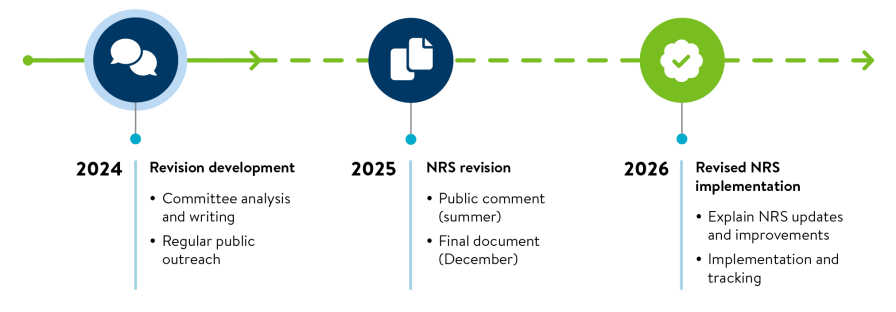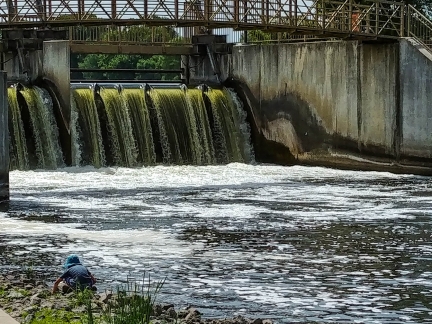Nitrate, phosphorus, and total nitrogen
Excessive nutrients, particularly phosphorus and nitrogen, pose a significant problem for Minnesota’s lakes and rivers as well as downstream waters including the Great Lakes, Lake Winnipeg, and the Gulf of Mexico. Nutrients enter our lakes and rivers from agricultural and urban lands and in discharges from wastewater treatment facilities. When nutrient levels exceed natural conditions, they can cause excessive algae growth, low levels of oxygen, toxicity to aquatic life, and unhealthy drinking water.
Minnesota established a statewide Nutrient Reduction Strategy in 2014 to guide our state’s efforts to reduce nutrient pollution. In 2024, the strategy is being updated with a revised strategy expected in late 2025.
Minnesota Nutrient Reduction Strategy
The Nutrient Reduction Strategy compiles the latest science, research, and data and recommends the most effective strategies to reduce nutrients in our waters from both point and nonpoint sources. The strategy serves as a framework that outlines voluntary and regulatory actions to reduce nutrient pollution to meet long-term goals. Reductions in Minnesota’s nitrogen and phosphorus pollution are needed to reach our in-state water quality goals and the 2040 goals that aim to restore the Gulf of Mexico, Lake Winnipeg, and Lake Superior.
- (2014)
Ten-year revision
The same 10 organizations involved in creating the original strategy are working on the 10-year revision, expected in late 2025. The goal of the revision is to safeguard water from excess nutrients and protect the health and well-being of Minnesotans and downstream neighbors.

Public participation begins in June 2024. State agencies will regularly update Minnesotans on the Nutrient Reduction Strategy revision process through web postings and informal information sessions. The draft revision is expected to take more than a year, with the revised strategy available for public comment in the second half of 2025.
Stay informed by signing up for email updates when the webpage is refreshed or attend an informal information session to learn more about specific parts of the revision.
Tracking progress
Adopting nutrient reduction practices in urban and rural areas is important for reducing nutrient pollution. Many state and federal government programs have set a priority goal of reducing nutrients in waters. Now you can look at the combined progress of these agencies.
Using special software, you can see where these programs are in use. Adoption of best management practices is tracked; the links below lead to interactive reports.
The software allows you to sort and illustrate by year how much of each program and where in Minnesota the best management practices have been adopted. By exploring this data we can better visualize and understand the potential to reduce nutrients. Additional best management practice adoption occurs outside of government programs.
- Best management practice adoption summary — statewide, large scale (2004-2022)
- Best management practice adoption summary — local level, watershed-scale (2004-2022)
- Tool to estimate nutrient reduction in rivers and streams from best management practice adoption
River nutrient monitoring, when conducted over the long-term and in multiple places, provides information useful for evaluating strategy success.
Each year, the MPCA updates river nutrient trends and river monitoring results on the most recently calculated loads and concentrations.
- Nutrient trends over time at MPCA-monitored sites (2001-2020)
- Daily and annual nutrient measurements at MPCA-monitored sites (approx. 2009-2020)
Watershed-based nutrient reduction efforts
Goals for nitrogen and phosphorus levels in waters downstream of Minnesota can be met if each watershed in our state does its part to reduce nutrients. The MPCA estimated how much nutrient reduction each watershed would be needed to achieve nutrient load reduction goals at the state line. This information can help us identify changes to achieve nutrient load reductions.
- This interim document will be updated in the 2025 NRS revision process.
The MPCA has also developed tools to estimate typical river nutrient pollution reductions expected with adoption of new practices on the land.
Five-year progress report

A 2020 report by Minnesota state agencies details implementation of the Nutrient Reduction Strategy from 2014 to 2019. The report focused on progress in three key areas: water quality trends, statewide programs to improve waters, and urban and rural practices adopted to reduce nutrients.
Water quality trends from 1998-2018 – Phosphorus concentrations are down but nitrogen concentrations are up. However, significantly higher rainfall in recent years has resulted in increased runoff that offsets progress made in reducing phosphorus and further increases nitrogen levels.
State-level programs – Minnesota has advanced more than 30 large-scale programs in the past five years to reduce nutrient pollution, but more time is needed to see results.
Changing practices at pollution sources – While wastewater treatment has helped reduce phosphorus levels and new practices were implemented on hundreds of thousands of acres of cropland, there is still a great deal of work to do in both urban and rural areas.
Other nutrient reduction efforts
Addressing nitrate in southeastern Minnesota
Multiple groups petitioned the U.S. EPA under the Safe Drinking Water Act claiming that nitrate contamination in some water systems in southeastern Minnesota was endangering public health. In December 2023, MPCA worked with other state agencies including the Department of Health and Department of Agriculture to respond. The MPCA will work with other government entities, community partners, landowners, and residents to develop long-term solutions that protect drinking water, address nitrate contamination in southeastern Minnesota, and support responsible farming practices.
Minnesota Department of Agriculture’s Nitrogen Fertilizer Management Plan
The Minnesota Department of Agriculture is responsible for nitrogen fertilizer use and management under the Groundwater Protection Act. To meet this need the department, in cooperation with a multi-stakeholder advisory committee and a public review process, developed a management plan.
The Minnesota Nitrogen Fertilizer Management Plan has recently been amended to reflect the new Groundwater Protection Rule. The plan is the state's blueprint for preventing or minimizing impacts of nitrogen fertilizer on groundwater.
Wastewater Nitrogen Reduction and Implementation Strategy
The MPCA has developed a wastewater nitrogen reduction and implementation strategy with the goals of meeting the Nutrient Reduction Strategy’s goals and providing protections for aquatic life.
New, expanded, and upgraded municipal and industrial wastewater treatment facilities require significant investments of public and private funds and are typically designed for a 20-year service life. Beginning April 1, 2024, wastewater treatment facility designs must include the treatment units and hydraulic capacity necessary to achieve future nitrogen effluent limits to maximize the benefit of impending investments and achieve nitrogen reductions as soon as possible.
Minnesota Office for Soil Health, Soil Health Action Framework
The Board of Water and Soil Resources partnered with the University of Minnesota's Water Resources Center to establish the Minnesota Office for Soil Health. In 2024, Minnesota’s State Soil Health Action Framework was issued.
The mission of the Office of Soil Health is to build local expertise to promote soil health, promote soil and water conservation, and provide outreach that will expand the tools and skills of Minnesota’s local conservation delivery community and promote understanding of the economic impacts of soil and water management practices.
EPA — Mississippi River, Gulf of Mexico Hypoxia Task Force
The Hypoxia Task Force was established in the fall of 1997 to understand the causes and effects of eutrophication in the Gulf of Mexico; coordinate activities to reduce the size, severity, and duration of the hypoxic zone (the dead zone) and lighten the effects of hypoxia, the lack of dissolved oxygen.
Trends in annual water-quality loads to the Gulf of Mexico
The U.S. Geological Survey provides annual reports on the amount of nutrient pollution flowing into the Gulf of Mexico from water quality samples taken from the Mississippi and Atchafalaya Rivers. Annual measurements and trend analysis are provided.
International Red River Watershed Board
Following the floods of 1997, the International Joint Commission established the International Red River Watershed Board to support the aquatic ecosystem integrity of the Red River Basin, including nutrient pollution.
EPA — Great Lakes Restoration Initiative
Beginning in 2010, the Great Lakes Restoration Initiative was the largest investment in the Great Lakes in recent decades. The initiative provides funding via grants for variety of activities and the direct implementation of Great Lakes Legacy Act projects.
The Great Lakes Restoration Initiative is a catalyst for unprecedented federal agency coordination to protect and restore the largest system of fresh surface water in the world.